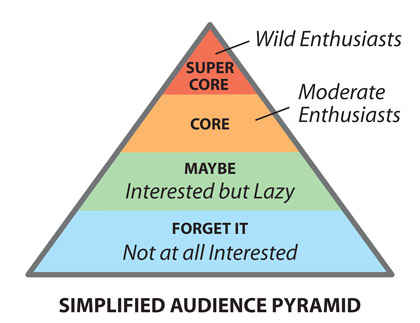MORE THAN CORE
By Susan J. McIntyre

Susan J. McIntyre, Founder
A Prescription for Stronger Response
PATIENT: "Doc, our catalog works great for our core audience. We know because we get tons of love letters from them. So why can't we improve response rates and grow faster?"
CATALOG DOCTOR: "Just like building your body, building a strong core audience for your catalog is important. But if you ONLY work on your core, you may be leaving the rest of yourself weak."
PATIENT: "You mean, like strong abs aren't enough, I have to also build up my arms and legs?
CATALOG DOCTOR: "Exactly. And 'HOW' is counter-intuitive: you must focus harder on selling to your marginal audience, not just to your core. The key is making it easier for fence-sitters to buy from you. You'll get higher response rates, higher growth, higher profits."
PATIENT: "How's my core audience different from my marginal audience?
CATALOG DOCTOR: "Let's look at the SIMPLIFIED AUDIENCE PYRAMID."

SUPER-CORE: Wild Enthusiasts, Wildly Loyal.
They'll work hard to buy from you, so your catalog does not have to work hard to sell to them...it just has to get your products in front of them. We love SUPER-CORE's, but there aren't enough of them to support a whole catalog business.
CORE: Moderate Enthusiasts.
They like your catalog, they understand what you're selling, and they're willing to make an effort to buy from you. Most catalogs work well enough for CORE customers. CORE's deliver quick growth out of the gate, but that growth levels off as you run out of universe.
MAYBE: Interested, But Lazy.
They'll buy, but not if they have to exert effort (like taking time to figure out something confusing). MAYBE's exist throughout your rented lists, and throughout your catalog-requester list too...it's just that when they get your catalog, there's too much standing in the way of buying. MAYBE's are even on your buyer list...but most never move beyond single-buyer status
FORGET IT: Not At All Interested.
Don't bother with these folks, investing in them is costly and wasteful.
Focus on the MAYBE's. You'll have to work harder to sell, but if you can convert more MAYBE's from prospects to tryers and from tryers to buyers, your response rates and profits will go up. And look at their size: the same as SUPER-CORE AND CORE combined. Tap into MAYBE's to recharge growth.
To convince MAYBE's to buy, you'll have to make some changes. But what's great is that these changes won't affect sales from your CORE customers, they'll just increase response rates from MAYBE'S. MAYBE'S just want you to make it easier for them to buy. Let's look at how:
Organize your product line for clarity
Don't assume that MAYBE's understand your product line as well as CORE's. Sales will rise when your product line is quickly and easily clear to less-than-knowledgeable MAYBE's.
Stash Tea has a chart that divides the teas into 4 quadrants, and within each quadrant is more detail that tells if a tea is "sweet", "spicy" and so on. Before that chart was invented, non-expert customers didn't understand the difference between "real" and herbal teas, or realize that some teas had caffeine, while others didn't, or that some teas had flavors added while others took their flavor from just the tea blends. Stash Tea was a groundbreaker (back in about 1984) in making the world of teas accessible to folks who were interested but not knowledgeable.
Light Impressions sells archival supplies to professional photographers and museums. Their product line is extensive and complex. Their catalog makes that product line accessible to a broad range of readers with a short, simple table of contents on the front cover ("Storage", "Protective Enclosures", "Mats", etc.), plus explanatory category intros at the beginning of each section.
Clarify the difference between similar products
What if you carry many products that are all similar to each other? CORE's know the difference. But how can non-expert MAYBE's decide which model is right for them?
Bill's catalog only works for CORE'S. It offers high-tech products that all do the same thing (like all cell phones do, all GPS devices do). Figuring out which model is right for them is easy for Bill's CORE and SUPER-CORE audience. But for non-expert MAYBE's, the catalog is hard to use, hard to understand. Yes, Bill's call center has knowledgeable, helpful CSRs to help callers choose the right model. But most MAYBE'S won't call. The catalog needs to be easy enough to use and understand that calling is the last step in deciding to buy, not the first step. The result for Bill: lost sales.
Light Impressions works for CORE's and MAYBE's. Here it quickly and simply explains how to choose between 2-ply, 4-ply or 8-ply matboard:
- "2-ply: Great for portfolio use where space is critical or as a backing board. 1/32inch."
- "4-ply: Creates adequate separation between your artwork and glazing [glass]. 1/16inch."
- "8-ply: A window in 8-ply adds depth and drama to any image. Also ideal for larger photographs or artwork that need more structural support. 1/8inch."
This type of information doesn't take much room, but makes deciding to buy easier, even for new-to-mats MAYBE's, lifting sales.
Be inclusive, not exclusive.
Use plain English. Avoid jargon or expert-shortcut copy, to avoid having MAYBE's feel intimidated, confused, or irritated...resulting in lost sales.
Let's say you're selling model airplanes. "Curtis SB2C; Metal; cockpit opens; 12x18 inches" is a completely adequate description for expert collectors or WWII Navy pilots. But MAYBE's will be clueless.
Alternatively, "Flying from U.S. carriers in WWII, the Curtis SB2C Helldiver destroyed more enemy targets than any other dive-bomber in the Pacific; metal; cockpit opens; 12x18in" is understandable to MAYBE's. Like novice collectors, or children of WWII Navy pilots looking for a gift.
Using plain English, and avoiding jargon and shortcut terms, will add appeal to MAYBE's, lifting response.
Explain what makes this product great
Most catalogers won't offer a product unless they think there's something great about it. Yet many catalogs do a poor job of communicating what that greatness is. Which means that MAYBE's will skip right over a product that they would have bought if its greatness had been clear.
Example: there are lots of backpack-style purses nowadays. Norm Thompson carries one. They could have described it the typical way, like "Backpack can also be worn as a shoulder bag. Leather." But instead they communicated its greatness. Here's part of the copy:
"As a shoulder bag, it stays quietly by your side, slouchy and chic in the richest, softest Napa leather. But a simple tug of the straps easily changes it to a backpack — comfortably out of the way and secured by a full-zip closure."
Even lazy MAYBE's will understand the bag looks stylish (important, most backpack-bags don't), that converting from shoulder bag to backpack is instant (important — no fiddling), and that it has a secure-close top (important — you can't keep your eye on your backpack). Communicating the greatness of a great product lifts sales — this bag is a Norm Thompson customer favorite.
Make extra information available
Once MAYBE'S are interested in a product, some want more information before deciding for sure to buy — and they want it quickly and easily.
Allen Brothers' catalog of prime beef has a section explaining beef terms, like "wet aging", "dry aging", "marbling" and "USDA Prime" that helps MAYBE's understand and choose.
Recipes, sizing notes, testimonials, craftsman profiles, added product details: all will help lift sales from undecided MAYBE's. What you can't fit in your catalog, put on the web, reachable in 1 or 2 clicks. Result: increased response rates, sales and growth.

